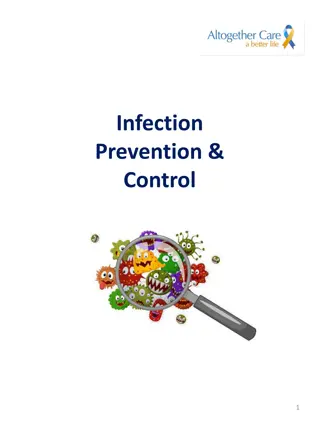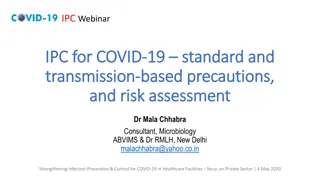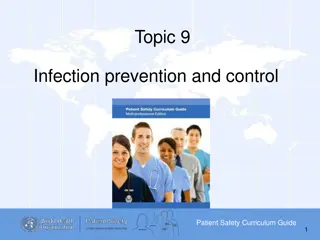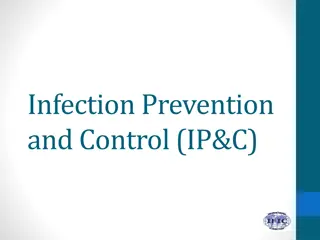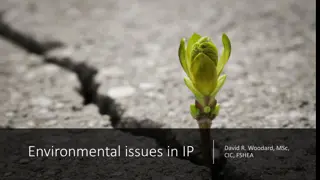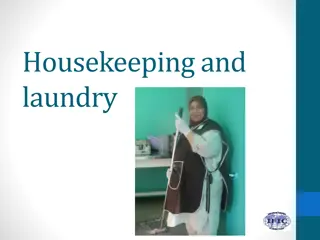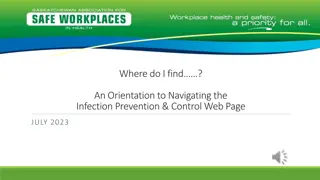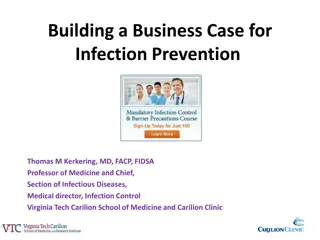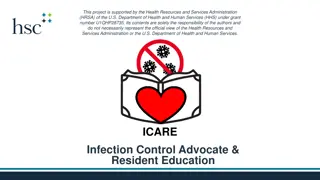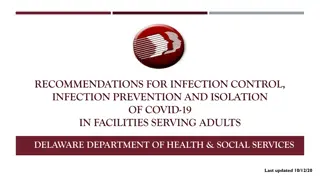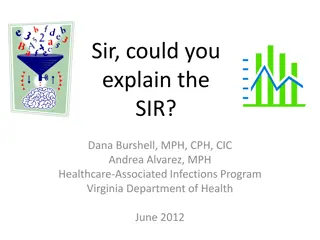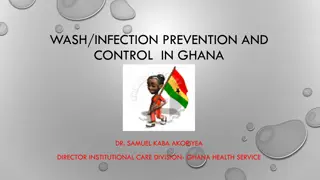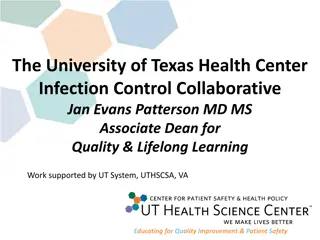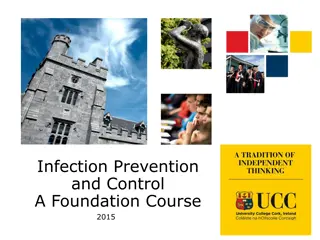Comprehensive Overview of Infection Prevention and Control Programs in Healthcare Settings
This comprehensive content covers the organizational structure, key points, learning objectives, time involvement, introduction, national programs, and health care facility programs related to infection prevention and control in healthcare settings. It highlights the importance of clear organizational structures, national guidelines, and ongoing surveillance to prevent healthcare-associated infections effectively.
- Infection prevention
- Organizational structure
- Healthcare programs
- National guidelines
- Healthcare-associated infections
Download Presentation

Please find below an Image/Link to download the presentation.
The content on the website is provided AS IS for your information and personal use only. It may not be sold, licensed, or shared on other websites without obtaining consent from the author. Download presentation by click this link. If you encounter any issues during the download, it is possible that the publisher has removed the file from their server.
E N D
Presentation Transcript
Organisational Structure
Learning objectives December 1, 2013 1. Describe how the infection prevention and control is organised in health care. 2. List the members of an infection control team. 3. Outline the topics contained in a typical infection control manual 2
Time involved December 1, 2013 45 minutes 3
Key Points Risk prevention for patients and staff is a concern of everyone in the facility and must be supported at the level of senior administration Infection Prevention and Control Programs require an appropriate, clear, and firm organisational structure Infection Prevention and Control Programs in most countries are delivered through an Infection Control Team An infection prevention and control manual compiling recommended instructions and practices for patient care is an important tool December 1, 2013 4
Introduction Each institution is unique and its specific needs must be considered when developing or reorganising an infection prevention and control (IP&C) program December 1, 2013 5
National Program National IP&C programs must: Set relevant objectives consistent with other national health care objectives Develop and continually update guidelines for health care surveillance, prevention, and practice Develop a national system to monitor selected infections and assess the effectiveness of interventions Harmonise initial and continuing training programs for health care professionals Facilitate access to products essential for hygiene and safety Encourage health care establishments to monitor healthcare-associated infections with feedback to the professionals concerned December 1, 2013 6
Health Care Facility Programs Risk prevention for patients and staff is a concern of everyone in the facility and must be supported by senior administration A yearly work plan should be developed to assess and promote good health care, appropriate isolation precautions, sterilisation and other practices, staff training, and epidemiological surveillance December 1, 2013 7
Health Care Facility Programs December 1, 2013 Appropriate arrangements must be in place for effective IP&C practices There is an Infection Control Committee (ICC) and an Infection Control Team (ICT) 8
Infection Control Committee (ICC) Provides a forum for multidisciplinary input, cooperation, and information sharing Is responsible for the planning, implementation, prioritisation, and resource allocation of all matters relating to IP&C Acts as a liaison between departments responsible for patient care and support services December 1, 2013 9
ICC Membership Chief Executive/Administrator or nominated representative Infection Control Officer/Doctor/Microbiologist who may act as chairperson Infection Control Nurse (ICN) Infectious Disease Physician (if available) Director of Nursing or his/her representative Occupational Health Physician (if available) Representatives from the major clinical specialties Representatives of other departments may be invited as necessary pharmacy, central supply, maintenance, housekeeping, training services, engineering/design, etc. December 1, 2013 10
ICC Overall Responsibility December 1, 2013 Holds regular meetings with minutes Produces an annual report and an annual business plan for the program 11
ICC Tasks - 1 To review and approve the annual plan for IP&C To review and approve IP&C policies To support the Infection Control Team and direct resources to address problems as identified To ensure availability of appropriate supplies needed for IP&C To review epidemiological surveillance data and identify areas for intervention To assess and promote improved practice at all levels To ensure staff training in IP&C and safety December 1, 2013 12
ICC Tasks - 2 To review infectious risks associated with new technologies and monitor risks of new devices and products, prior to their approval for use To review and provide input into an outbreak investigation To review and approve construction/renovation projects regarding infection prevention To communicate and cooperate with other committees with common interests, such as Antibiotic/Pharmacy Committee, Occupational Health Committee, etc. December 1, 2013 13
Infection Control Team (ICT) December 1, 2013 The team should have a range of expertise covering infection prevention and control medical microbiology healthcare epidemiology infectious diseases nursing procedures 14
ICT Responsibilities December 1, 2013 Is responsible for the day-to-day running of Infection Prevention and Control programs Must have appropriate authority 24 hour access to the ICT for advice on IP&C issues is essential 15
ICT Role - 1 To develop an annual IP&C plan with clearly defined objectives To develop written policies and procedures, including regular evaluation and updates To prepare an action plan for implementation of the IP&C program with approval from the Infection Control Committee To monitor and evaluate daily practices of patient care designed to prevent infection To identify problems in the implementation of IP&C activities which need to be solved or addressed by the Infection Control Committee December 1, 2013 16
ICT Role - 2 To organise epidemiological surveillance for healthcare-associated infections To investigate outbreaks and provide data (and expert advice) that should be evaluated to allow for any change in practice or allocation of resources To educate all grades of staff in IP&C policy, practice, and procedures relevant to their own areas To provide advice to all grades of staff on all aspects of IP&C on a day-to-day basis December 1, 2013 17
ICT Role - 3 December 1, 2013 To develop an annual training plan for healthcare workers and implement IP&C training activities To ensure availability of supplies and equipment needed for IP&C-related activities To have a scientific and technical support role in purchasing and monitoring of equipment and supplies, and in evaluation and checking the efficacy of sterilisation and disinfection measures 18
ICT Role - 4 To collaborate with the pharmacy and antibiotic committees in developing a program for supervising antibiotic use To support and participate in research and assessment programs To participate in audit activities To obtain program approval from the Infection Control Committee To submit monthly reports on activities to the Infection Control Committee December 1, 2013 19
Composition of the ICT December 1, 2013 Consists of at least one physician, the Infection Control Officer/Doctor and at least one nurse, the Infection Control Nurse 20
Infection Control Officer (ICO) - 1 December 1, 2013 Is a medically qualified senior staff member who is interested in and who spends most of his/her time involved in IP&C Typically a medical microbiologist, an epidemiologist, or an infectious diseases physician May also be called an Infection Control Doctor or Hospital Epidemiologist 21
Infection Control Officer - 2 December 1, 2013 Serves as a specialist advisor and takes a leading role in the effective functioning of the Infection Control Team Should be an active member of the Infection Control Committee and may act as its Chair Assists the Infection Control Committee in reviewing annual plans, policies, and long-term programs for the prevention and control of infection 22
Infection Control Officer - 3 December 1, 2013 Advises the Chief Executive/Administrator directly on all aspects of IP&C and on the implementation of policies and procedures Participates in the preparation of tender (bid, offer) documents for support services and advises on IP&C aspects Must be involved in setting quality standards, surveillance, and audits with regard to infection prevention 23
Infection Control Nurse (ICN)- 1 Is a registered nurse with an academic education and practical training which enables him or her to act as a specialist advisor in all aspects relating to IP&C Perhaps with a qualification, such as specialised training Is usually the only full-time practitioner on the Infection Control Team and therefore takes the key role in day-to-day IP&C activities Role may be filled by someone other than a nurse in some countries. Titles vary. December 1, 2013 24
Infection Control Nurse - 2 December 1, 2013 Contributes to the development and implementation of policies and procedures, participates in audits, and monitors tools related to IP&C and infectious diseases Provides specialist-nursing input in the identification, prevention, monitoring, and control of infection Participates in surveillance and outbreak investigation activities 25
Infection Control Nurse - 3 December 1, 2013 Identifies, investigates and monitors infections, hazardous practices and procedures Participates in preparing documents relating to service specifications and quality standards Participates in training and educational programs Is a member of relevant committees where Infection Prevention and Control input is required 26
Infection Control Link Nurse (ICLN) - 1 December 1, 2013 These individuals have special responsibility for maintaining good IPC practices and education within their departments Is the link between the Infection Control Nurse and the ward Helps identify problems, implement solutions, and maintain communications 27
Infection Control Link Nurse - 2 December 1, 2013 The ICLN is responsible for: Monitoring hygiene, consistent with policies and good nursing practices Monitoring aseptic techniques, including hand hygiene and use of isolation precautions Reporting promptly to the attending physician any evidence of infection in patients Initiating patient isolation/precautions and ordering culture specimens from any patient 28
Infection Control Link Nurse - 3 December 1, 2013 The ICLN is responsible for: Identifying signs of a communicable disease when the physician is not available Limiting patient exposure to infections from visitors, staff, other patients, or equipment used for diagnosis or treatment Maintaining a safe and adequate supply of ward equipment, drugs, and patient care supplies 29
Infection Control Manual - 1 December 1, 2013 Establishes standards for performance Contains recommended instructions and practices for patient care Topics include: Patient care Hand hygiene Isolation precautions practices Invasive procedures (intravascular and urinary catheterisation, mechanical ventilation, tracheostomy care, and wound management) Oral alimentation 30
Infection Control Manual - 2 December 1, 2013 Topics include: Area specific procedures Isolation precautions procedures for infectious patients Surgical and operating theatre techniques Obstetrical, neonatal, and intensive care techniques Processing of items of critical importance Cleaning, sterilisation, and disinfection Medication and preparation of infusions (including blood products) 31
Infection Control Manual - 3 December 1, 2013 Topics include: Staff health Immunisation Post-exposure management for employees, patients, and others exposed to infectious diseases within the facility Investigation and management of patients with specific infections Methicillin-resistant Staphylococcus aureus (MRSA) Diarrhoea Human immunodeficiency virus Tuberculosis Multi-resistant Gram-negative bacteria 32
References - 1 Ducel G, Fabry J, Nicolle L. Prevention of hospital-acquired infections; A practical guide, 2nd ed. World Health Organization, Geneva, Switzerland; 2002; 9. http://www.who.int/csr/resources/publications/WHO_CDS_CSR_EP H_2002_12/en/ Scheckler WE, et al. Requirements for infrastructure and essential activities of infection control and epidemiology in hospitals: a consensus panel report. Infect Control Hospital Epidemiol 1998; 19: 114-124. http://www.shea- online.org/Assets/files/position_papers/IC-Infrastructure98.PDF Friedman C, et al. Requirements for infrastructure and essential activities of infection control and epidemiology in out-of-hospital settings: A Consensus Panel report. Am J Infect Control 1999; 27(5): 418-430. http://www.ncbi.nlm.nih.gov/pubmed/10530650 Brannigan ET, Murray E, Holmes A. Where does infection control fit into a hospital management structure?J Hosp Infect 2009: 73(4): 392-396. December 1, 2013 33
References - 2 Essential Resources for Effective Infection Prevention and Control Programs: A Matter of Patient Safety: A Discussion Paper 2010. Public Health Agency of Canada http://www.phac-aspc.gc.ca/nois-sinp/guide/ps- sp/index-eng.php Friedman C, et al. APIC/CHICA-Canada infection prevention, control and epidemiology: Professional and practice standards. Am J Infect Control 2008; 36 (6): 385- 389. http://www.chica.org/pdf/08PPS.pdf Gordts B. Models for the organisation of hospital infection control and prevention programmes. Clin Microbiol Infect 2005; 11 Suppl 1:19-23. December 1, 2013 34
Quiz 1. The infection prevention and control program is often overseen by an Infection Control Committee. T/F? IC link nurses are responsible for: a) Day-to-day activities of the IPC program b) IC education of all staff c) Monitoring local practices d) All of the above An Infection Control Manual helps a facility: a) Keep track of its infections b) Investigate outbreaks c) Establish standards of practice d) All of the above December 1, 2013 2. 3. 35
International Federation of Infection Control IFIC s mission is to facilitate international networking in order to improve the prevention and control of healthcare associated infections worldwide. It is an umbrella organisation of societies and associations of healthcare professionals in infection control and related fields across the globe . The goal of IFIC is to minimise the risk of infection within healthcare settings through development of a network of infection control organisations for communication, consensus building, education and sharing expertise. For more information go to http://theific.org/ December 1, 2013 36 36




